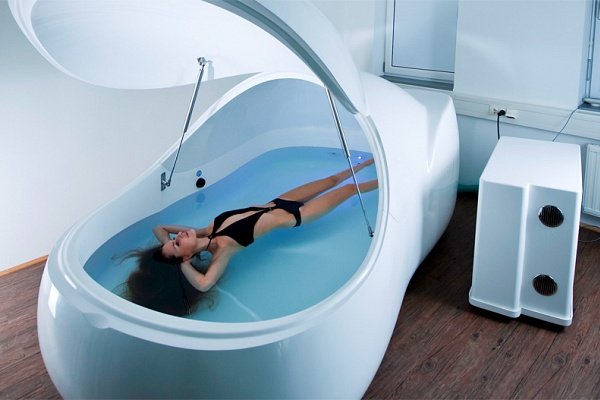01 February 2022, by i-sopod
Spiralling into negative thought patterns? Feeling paralysed by doubts and fears? Spending too much time worrying about things that will probably never happen?
Anxiety is arguably the pandemic of our times. With 42% of people experiencing an anxiety disorder at some point of their lives, mental health care is paramount, and the wellbeing industry is booming with techniques old and new to ease our weary minds.
Floatation is an effective therapy for relieving anxiety, and a very effortless method too.
How can time in a float tank help with anxiety? And does one session show results, or do you have to float regularly to see a difference?
Let’s break down some of the main ways in which floating can soothe anxiety.
Lowers cortisol levels
Cortisol is the primary stress hormone which helps you stay alert and reacting to potential threats. Cortisol puts your brain into fight-or-flight mode, curbing any non-essential functions happening the body in order to focus on survival.
If you’re in fight-or-flight mode too often, this can eventually take its toll on your mental and physical state. Your body ends up depleted, and you find yourself feeling anxious, weary, and of course, stressed.
There are a number of ways in which a hyper stimulated modern life trigger prolonged cortisol release; like the blue light omitted by your devices, for example.
Floating regularly is proven to reduce cortisol levels in the body by over 20%. This is because magnesium sulphate (aka Epsom salts) inhibits ACTH, the hormone which tells your adrenal glands to release cortisol.
When cortisol levels are brought down to a healthy level, this has a beneficial effect on your overall wellness. The immune system is regulated, as is bowel function and blood sugar. Sleep quality also improves, and poor sleep is known to contribute to anxiety.
Activates the para-sympathetic nervous system
Being in a zero gravity environment causes your muscles and nerves to completely let go and release tension. When the spinal cord is able to relax in this way, the body comes out of fight-or-flight (operating the the sympathetic nervous system) and the parasympathetic nervous system takes over, putting you into rest-and-digest mode.
Rest-and-digest is the state which allows your body to heal from stress and tension, causing anxiety to melt away.
Lowers blood pressure
When you’re feeling anxious the body responds by increasing your blood pressure, which can cause physical discomfort, brain fog and fatigue, all symptoms which perpetuate anxiety.
Thanks to its high magnesium content, the float tank is a great place to lower your blood pressure naturally. Transdermal absorption of magnesium (i.e through the skin) is a very effective way of topping up your magnesium levels, a mineral which most of us are deficient in. Read more about what magnesium does in the body here.
Causes interoception
In float therapy, your external senses are given a much needed rest, and you experience no stimulation from the outside world. This causes your awareness to turn inward, as you become more conscious of internal sensations in the body.
Interoception is when you become aware of sensations in your body – from the inside out. You begin to really feel how your body is doing, as you tune into your heartbeat, your breath, and other physical processes.
Now this could sound counter intuitive; as some people who struggle with anxiety might find the idea of being more aware of their breath and heart rate daunting.
A research project led by Dr Justin Feinstein in 2018, however, has proven that heightened interoception is actually conducive to relaxation and reducing anxiety.
Induces theta brainwaves
Meditation is a valuable tool for managing anxiety and stress in your every day life, which has been practised for millennia. That said, it can be quite hard to find the motivation or discipline to get into meditation.
Floatation provides a great bridge into meditation, making it ideal for beginners and for people who (like most of us at some point) struggle with a restless, worrisome mind.
Theta brainwaves operate at a frequency of 4-8hz, which puts the brain into a deep meditative state. Through traditional meditation, getting the brain into a theta state can take hours of dedicated practice – while floatation can get you there effortlessly.
The beauty of float therapy is that you don’t have to try to relax: the tank environment – with zero gravity, no external stimulation and concentration of magnesium – is designed to get you relaxed, and proven to be highly effective.
For more on floating as a gateway into meditation, read this.
It’s evident that floatation can have anxiety reducing effects. While some of the benefits are cumulative, (for instance, you will need to float regularly to see a significant reduction in cortisol levels and blood pressure) it’s proven that just one session in a float tank can have a direct anxiolytic effect.
In just one float session, your parasympathetic nervous system will be activated, which supports your mind in relaxation and eases some of the mechanisms that led to you feeling anxious in the first place.
This makes floatation beneficial for anyone dealing with mild to severe anxiety, chronic stress and also depression (which 50% of the time goes hand in hand with anxiety).
This trial showed that after an initial 20 minutes of the float therapy session, participants began to feel more relaxed and levels of anxiety went down.
‘I felt detached from the world in a good way while floating as if I was in a sanctuary.’ Trial participant
Wondering what the other benefits of floatation are? Float therapy provides a wide spectrum of holistic effects, for both mind and body.
Here’s how floatation supports sport recovery for athletes and avid gym goers, and read this to learn how floating helps during pregnancy. Finally, head to our blog for a number of other float related topics.






